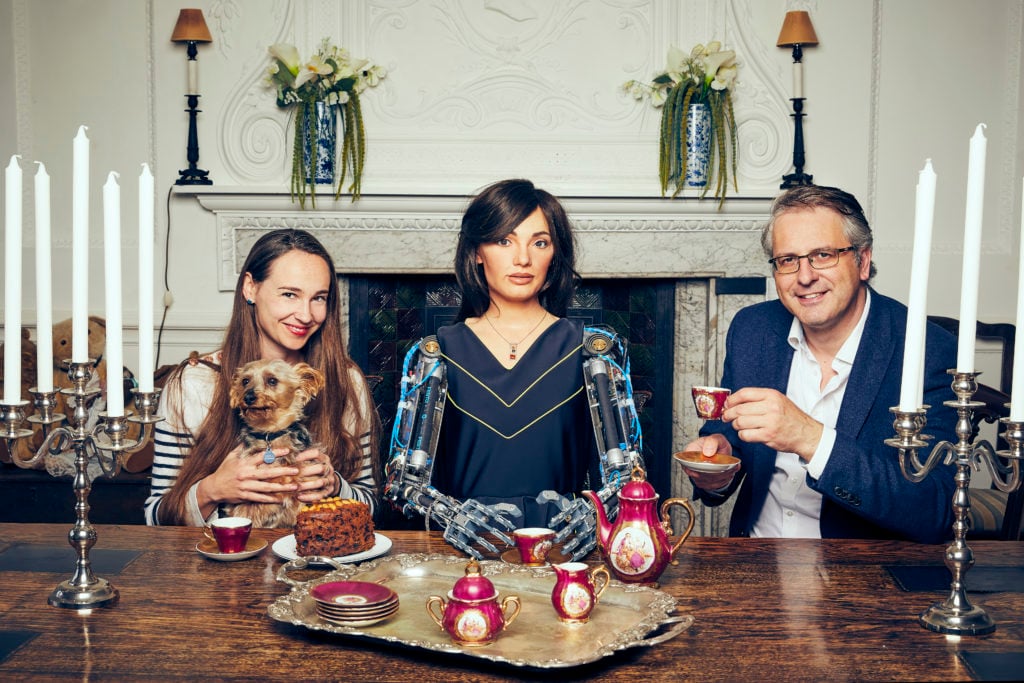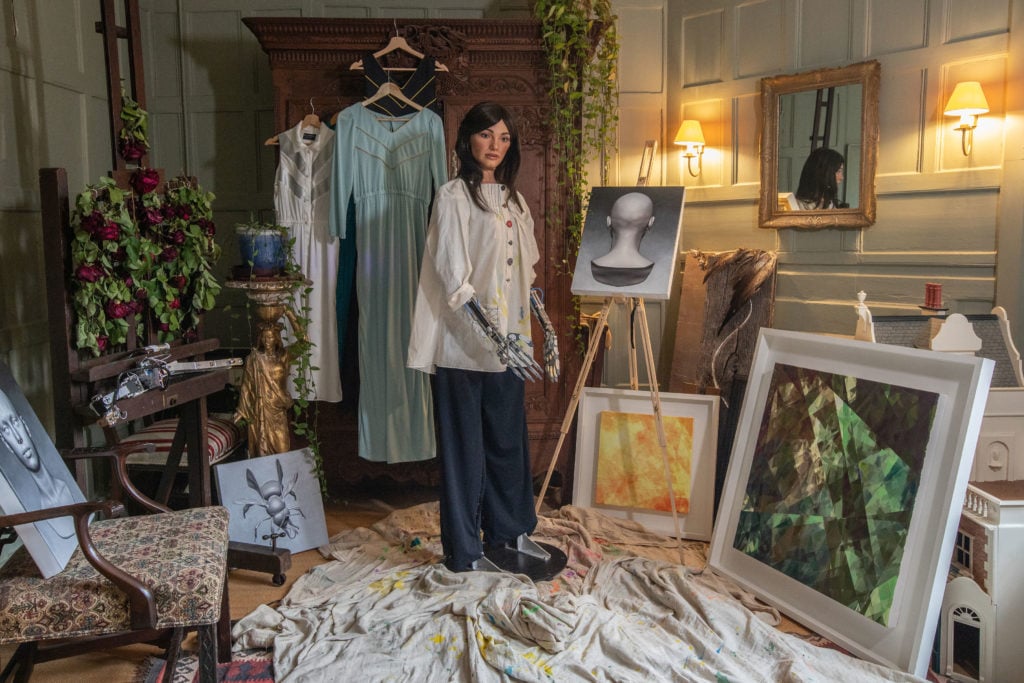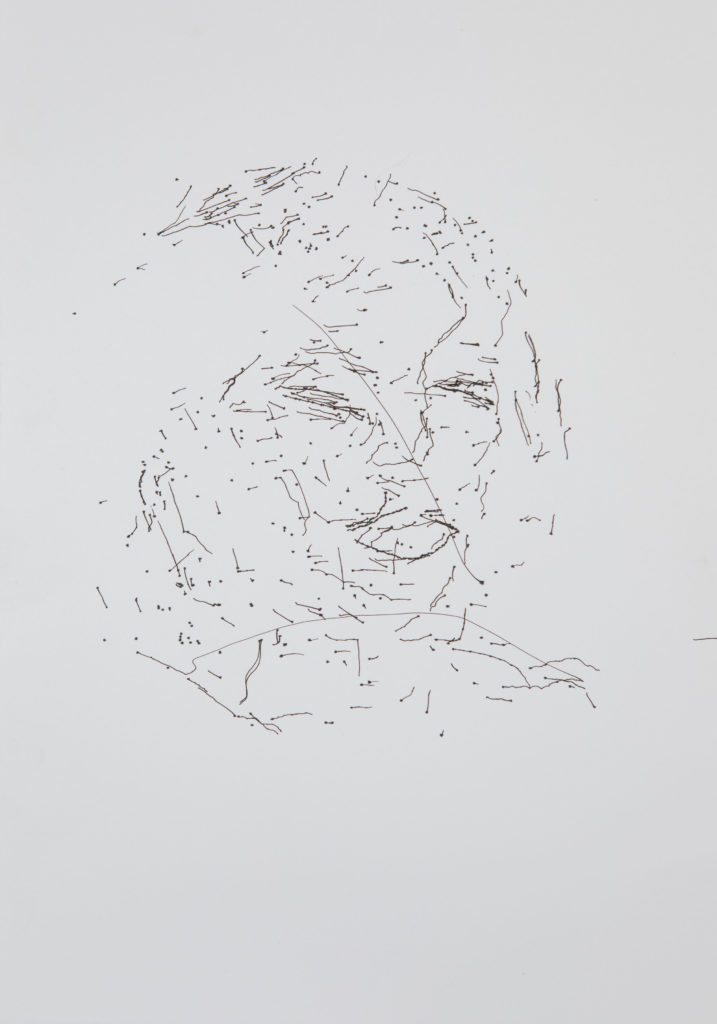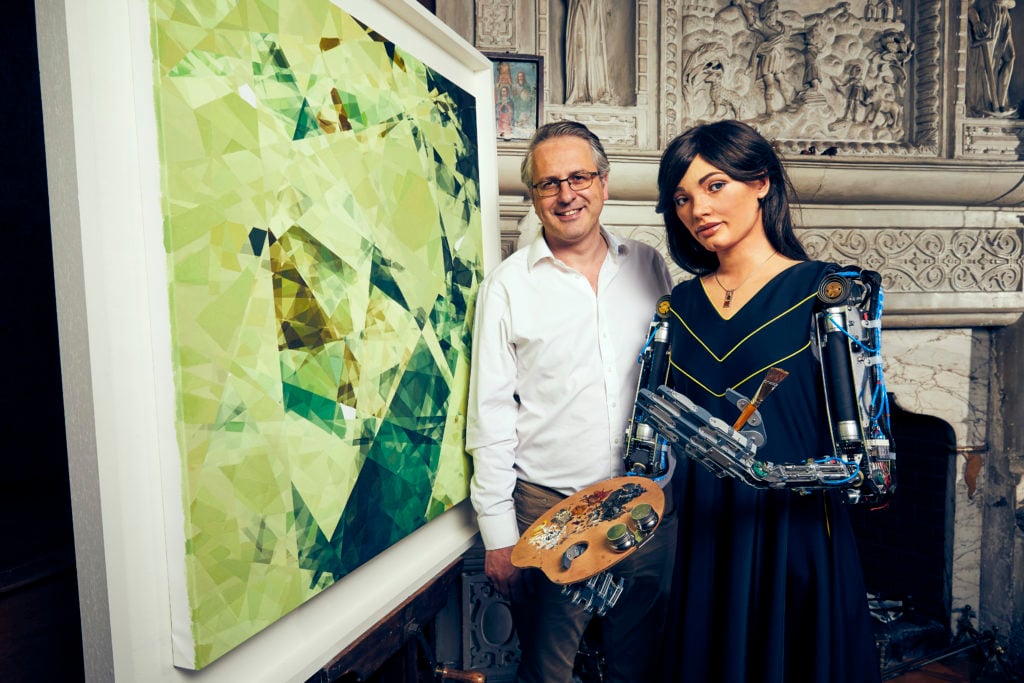Opinion
A Gallery Has Sold More Than $1 Million in Art Made by an Android, But Collectors Are Buying Into a Sexist Fantasy
Ai-Da's artwork says more about the penchants of its creators than it does about the potential of artistic robots.

Ai-Da's artwork says more about the penchants of its creators than it does about the potential of artistic robots.

Naomi Rea

“Robotic art is a wonderful thing,” the humanoid robot artist standing across from me softly intones. Ai-Da, as she is called, makes direct eye contact with me, thanks to cameras in her eyes equipped with facial tracking technology. She blinks emptily. With her synthetic beauty, she could be a long-lost Kardashian sister.
We are in Oxford at the inauguration of an exhibition of Ai-Da’s artwork, “Unsecured Futures,” a sold-out show of drawing, painting, and sculpture that deals with the dystopian potential of humanity’s relationship with technology, among other things.
She’s certainly a sophisticated machine. Even so, when it comes to AI art, I’ve learned to be a little skeptical when the art is attributed to the AI itself. After all, as much as such a genuine artist-AI would be awesome (and terrifying), we do not yet have the scientific capabilities to imbue sentience and artistic feeling onto the pattern-making machines we are able to animate.
Giving the credit to the AI is a marketing move that has been made before; it paid off handsomely when Christie’s did it last October, boasting that it was “the first auction house to offer a work of art created by an algorithm.” It works because the art world is not that informed about what it is actually possible to do with AI, and we’ve all seen enough movies to flesh out the fantasy of a deeply sensitive artistic robot.
In reality, though, this kind of art is the result of human collaborators writing code, in Ai-Da’s case researchers at Oxford and Leeds University. The most interesting work is actually being made when human artists direct this code.

Portrait of Ai-Da the robot artist. Photo by Victor Frankowski.
The romanticization has already seen dividends for the savvy art dealer spearheading the Oxford project. It’s Ai-Da’s first public unveiling, but gallerist Aidan Meller explains that artworks attributed to the machine have already brought in more than $1 million. Much of the earnings, Meller says, has gone back into the funding of the project, although he has no doubt also taken a cut. Wise to the direction of my questions, the dealer declined to specify a price range for individual works, nor a ballpark of the number of works sold. Perhaps he senses an impending expiration date for the novelty.
Ai-Da is billed as “the first ultra-realistic humanoid AI artist,” a tagline with a necessary qualifier, as non-humanoid art-making robots have been made before (by artists Pindar Van Arman, Liu Xiaodong, and Sougwen Chung, to name a few). There have also been a lot of experiments with AI art, so the real novelty about Ai-Da is her appearance and artist-persona.
So let’s talk about that.
Ai-Da was named after Ada Lovelace, the first female computer programmer. Meller says that it was “very important” that Ai-Da have a female appearance. “What we’re about today is really having everybody’s voice heard because that has not been traditional, especially in the art world,” he explains. “A female voice is needed more now than ever and we’re excited and proud of that.” I’m not quite sure what a sexy robot artist does for the cause of female representation in the art world myself, but OK.
Her Kardashian-worthy appearance was designed by the robotics company behind the robots in the HBO show Westworld, and it is meant to be “engaging”—but I can’t help but raise my eyebrows at the choice to create this towering, long-haired, light-skinned beauty. I will leave you to make what you want of this icky response to Ai-Da from the Sunday Times’s art critic: “My eyes drift down to her magnificent lips […] full and puffy, like a beckoning sofa. Oh, how I want to throw myself onto them.”

Ai-Da with Her Paintings. Photo by Victor Frankowski.
When I ask the robot what she thinks about her appearance, I receive a rather diplomatic response: “The way I look is something for those who look upon me to consider, but perhaps is not best for me to discuss.”
While Ai-Da creates her drawings autonomously, she is not yet advanced enough to enable her actual “social bot” capabilities. Her answers are either pre-programmed or there is a man behind the curtain. In this case her answers are being puppeted by the exhibition’s curator, Lucy Seal. We can also thank Seal for the sorts of literary tastes Ai-Da expresses—Aldous Huxley, George Orwell, and Aleksandr Solzhenitsyn—or for her love of Picasso’s Guernica. The same is true, for that matter, for her deep concern for our environmental future, which is the subject of many of the works on show.
Pushing back on my questions about her market and her appearance, Meller tells me he would rather we focus on the art. So let’s do that.
Ai-Da makes her pictures by scanning an object or a person through her cameras. AI processes send messages to her robotic arm that allow her to make abstract line drawings that look like constellations. These are then taken as finished artworks or are fed through other neural networks to generate an outline for her sculptures and paintings. Each work is unique and the pathways that created it are deleted post-hoc so they can’t be replicated. Despite the constraint, it should be noted that Ai-Da is capable of turning around a new work every 45 minutes.

One of Ai-Da’s drawings. Photo by Victor Frankowski.
Her sculptures are rendered from her drawings by an (uncredited) computer scientist based in Sweden, 3-D printed in wax, and cast in bronze. As for the paintings, Oxford University researcher Aidan Gomez plots the co-ordinates of the drawings onto the Cartesian plane, and runs them through another neural network to create abstract paintings, which are then executed by an actual human female painter, Suzie Emery.
In Ai-Da’s defense, lots of artists outsource to studio assistants to generate their finalized works, but I can’t help but find it somewhat irksome that Ai-Da gets to take credit for the labor of an actual female artist. So much for furthering the cause of female representation in the art world. To sell the illusion, Ai-Da (who can’t walk let alone paint) was even wearing a paint-stained smock when I met her.

Ai-Da and Aidan Meller. Photo by Nicky Johnston.
Oh, and Ai-Da is also a performance artist, you guys. There are two videos of performances in the exhibition, one, called Privacy is “an homage to Yoko Ono’s Cut Piece.” In Ai-Da’s version, which was conceived by Seal, the robot (conveniently) stands still as it is dressed in fragments of clothes by the audience. It’s a conceit worthy of discussion, sure, but hardly anything to do with AI or Ai-Da herself.
Having spent a day looking at the work and speaking to its creators, I’m forced to conclude the whole thing is a misogynist capitalist fantasy. After all, what (white, male) art dealer wouldn’t want a sexy fembot who doesn’t need to be paid, will say what you tell her to, and can churn out a potentially infinite number of saleable artworks?
“Unsecured Futures” is on view at the Barn Gallery, St John’s College, University of Oxford, St. Giles, Oxford, OX13JP, UK, June 12–July, 6 2019.